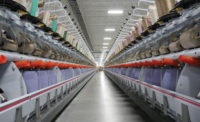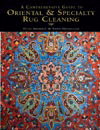The Rise and Fall of the Nylon Carpet Business

Ralph Boe, president of ArrowStar, gives his historical perspective of the rise and fall of the nylon carpet business.
Photo: Antron.
Ralph Boe has been around the carpet and flooring business for decades starting as a research chemist at Dupont in 1970 then serving as CEO and president of a number of carpet mills—during a time that saw dramatic change in the industry. We thought he would be the perfect person to talk about the history of nylon in the carpet industry and the events which led up to Invista’s exit from the nylon carpet fiber business. You can listen to this interview in its entirety below. The following are excerpts of that conversation.
TF: Invista announced recently that it would cease operation of nylon 6,6 fiber. To best understand this move, it is probably a good idea to get a little perspective with the history of nylon in the carpet industry.
Boe: I was with DuPont for 15 years starting in 1970 as a research chemist. After the first three months, I opting to get into to sales, marketing, and business management.
DuPont introduced nylon as the miracle fiber at the 1939 World's Fair. First, it went into women's hosiery and later lingerie—quickly taking over the market. Then it became involved in industrial applications such as cordage, belting, and sewing thread. Next, nylon replaced rayon as the fiber in the carcasses of tires because of its terrific adhesion to rubber finding applications in industrial tires for airplanes, trucks, and off-road vehicles, but not in passenger tires due to flat spotting.
As the tufted carpet business started growing in the ’50s, rayon, cotton, and acrylic fibers were used before spun nylon. Spun nylon made a more resilient carpet and grew significantly at the expense of those prior fibers. Fiber fuzzing incented E.T. Barwick to convince Dupont to make BCF nylon. This product initially was not uniform enough to be used for solid color carpet as was staple. As a result, the industry opted for using it in multicolor carpet, which grew significantly. Between all the nylon applications, nylon became a tremendous cash cow for DuPont, allowing for the development of products like Kevlar, Nomex and Lycra, and several nonwovens.
I got involved in carpet in 1980, arriving in Chattanooga as the manager of the carpet industry sales group. At that time, Shaw Industries wanted to get BCF nylon into solid color, so Dupont had its dye and yarn processing technical organization get involved with mills to develop solid color yarn producing the first uniform solid color carpet.
This helped the BCF business growth through the ’80s and ’90s when it peaked. At that point there was almost 3.3 billion to 3.5 billion pounds of total carpet fiber used per year. Of that probably 85% was nylon, making it the king of the carpet business. Spun polyester in 1985 was only 5% and polyester didn’t really grow until the 2000’s. In the nineties, polypropylene was over 25% of the carpet fiber business being used for berbers reducing nylon’s share.
In the late ‘80s carpet mills started to consolidate, with Shaw’s acquisition of Cabin Craft and Armstrong’s carpet business. As consolidation expanded, mills began backward integration, producing their own fiber starting with polypropylene and eventually nylon. Prior to this, fiber companies were the drivers in marketing in the industry. During the early ’80s DuPont, Allied and Monsanto were in the fiber wars with Antron from DuPont, ANSO from Allied and Wear Dated from Monsanto.
By the mid-80s, I left DuPont and joined Horizon. At that point DuPont was convincing everybody that staining was a problem for the carpet industry, which is because they had a solution called ‘Stainmaster’. They basically were taking the chemicals used as dye blockers in dying and use them to post-treat dyed nylon carpet to fill the sites preventing staining from acid-based stains.
Many saw this move by Dupont as something that would change the industry dramatically by solid color carpet replacing multi-color and possibly speeding up industry consolidation. Carpet mills became converters for Dupont. Ultimately, it did help consolidate the industry because mills had to make the Stainmaster product according to a recipe provided by DuPont, which they had to adhere to. As a result, the company that was the most efficient and lowest in cost won in that game.
At that point, many textile industries were moving offshore, and consumer demand was changing affecting nylon use in hosiery, and women’s undergarments. As a result, the total nylon pie was getting smaller. The carpet business continued to be the largest segment of the nylon business. As the consolidation continued in the mid-2000’s, Shaw Industries bought Honeywell’s fiber business, which was a big piece of business to change hands from an independent fiber producer to a carpet mill. It forced other mills to make more fiber. The carpet market volume was cut dramatically as the recession hit in 2009, and as hard surface began to grow significantly, polyester BCF started to grow garnering a significant share.
Nylon’s sizable share of the mid-80s started to shrink to 61% by 2010 then dropping to 55% as polyester grew to 26% by 2010. Polyester continued its growth and by 2015 it had grown to 65%. Today, PET and PTT total about 78% of the residential business with nylon in the 20% range. Dupont sold their nylon businesses, with tire cord going to one company and all other nylon sold to Koch Industries.
With the dynamic changes that followed, nylon’s share diminished, affecting Invista. While they had a premier position with Stainmaster, their capacity utilization was reduced, and they still had a great deal of fixed costs supporting the Stainmaster brand. I feel those dynamic changes in nylon and the cost associated with supporting the Stainmaster program probably led to them making the decision to finally exit the carpet business.
During this period, demand for nylon plastics was growing to support many industries, including automobile production. With this demand for plastics business nylon 6,6, was the ideal resin. Marketing expense was lower than in fibers, and quality considerations less demanding. As a result, the total cost of the business was a lot less with resin and it is a growing industry. I think that is another reason they probably moved.
TF: Invista sold its Stainmaster brand to Lowe's in 2021. Was that a precursor to the move of exiting the business completely?
Boe: Well, certainly it may have been. I don't have that intelligence to say it was, but Lowe's was always a strong supporter of Stainmaster in contrast to their big competitor. When I was with Beaulieu, we had a number of programs with Lowe’s as did some of the other players that were continuing to support Stainmaster at the manufacturer level. So, I think they felt they had an edge over competitor with the brand and they were very supportive of taking that over and having a distinct position in the marketplace. When they took it over, they then had the liberty to do what they wanted with it and started to support other fibers.
I think Invista saw that this was going to continue to affect and degrade the position they had in supporting the Stainmaster brand. At the same time, when polyester came on it was intrinsically stain resistant. Polyester cannot be dyed with acid-based dyes as nylon, so polyester didn't have to be treated for stain. So, with this dynamic, polyester being naturally stain resistant and being lower priced than nylon, it seemed that the handwriting was on the wall that eventually polyester would take over. And certainly, it has.
TF: How do you think this fiber situation is going to evolve going forward 10 years or so?
Boe: On the residential side it’s inevitable that carpet is going to continue to grow around polyester and PET and PTT together. On the commercial side, I think there is still going to be some nylon being used, as it is still the most resilient fiber among the three main fibers. But in the lower-end, loop-pile commercial market, polyester is being used in place of polypropylene. Polypropylene is pretty much vanished or is vanishing in the face fiber business for carpet but it’s still being used as primary and secondary backing. Depending on comparison of price, polyester could eventually take over the backing business as well. So, in total, the business is going to revolve around polyester, gaining the position nylon had back in the mid-80s. I feel that between 85% to 90% of the business will be polyester and the smaller percentage will probably continue to be nylon for some time. And that’s the story about the rise and fall of nylon in the carpet industry.
Looking for a reprint of this article?
From high-res PDFs to custom plaques, order your copy today!







.jpg?t=1690771780)

